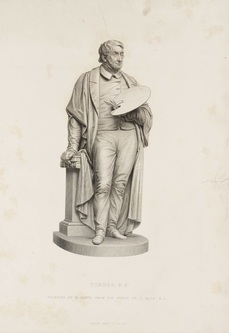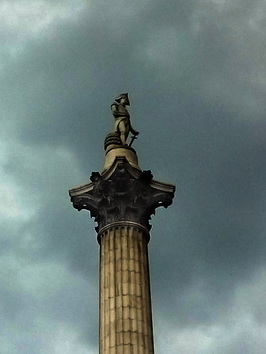|
Memorial by sculptor of Nelson’s column in Tottenham
Edward Hodges Baily RA, the sculptor of the figure of Admiral Lord Nelson at the top of Nelson’s Column in Trafalgar Square, also carved the memorial to Mary Windus, BG Windus’s first wife, which is in Holy Trinity Church on Tottenham Green. Edward Baily, born in 1788, was one of the most prolific sculptors in Victorian Britain. He was known for his poetic sculptures, such as Eve Listening to the Voice which is at the Victoria and Albert Museum, and also for over 130 portrait busts of the great and the good. He was a student at the Royal Academy from 1809, winning the Royal Academy Schools gold medal in 1811, and elected a Royal Academician in 1821. |
|
In 1856 EH Baily designed a gold medal for landscape painting for which JMW Turner had bequeathed £20,000, however, the Academy decided to use a portrait of Turner by Daniel Maclise RA on the front and a design by William Dyce RA on the back.
Edward Baily was declared bankrupt several times in his life and delayed payments by the authorities and patrons, including the Royal Family, were a major factor. In 1831 the Treasury had to be reminded that final payment for work on the Marble Arch was three years overdue. It is has been suggested that he may have been extravagant at times, but maintaining a large family and suffering from a liver complaint must have also taken their toll. In 1833 he wrote to the council of the Royal Academy, asking them to adopt measures to improve the distressed state of sculpture. He retired in 1862 and was given a pension the following year. Although he was regarded as one of the most successful sculptors of the century, by the time of his death in 1867 he was out of fashion and died bankrupt. Elhanan Bicknell, Robert Vernon, John Sheepshank and other prominent collectors of JMW Turner were also enthusiasts of Baily’s work. Bicknell owned nine sculptures including one of the versions of Eve Listening to the Voice. Vernon possessed a copy of Eve at the Fountain, the figure which gave Baily a European reputation and was seen as a marble inspiration softened into life, further described by Henry Weekes as one of the most beautiful examples of English ideal Sculpture as yet known to us. John Sheepshank, the Leeds clothing magnate commissioned a memorial for his father, Joseph, in 1819. Most collectors of Baily’s ideal figures – men such as Bicknell and McConnel – tended only to collect works by British artists and were far from ‘international’ in their artistic interests. One of the notable features of Baily’s career was his failure to secure the patronage of the three major and pioneering collectors of modem ideal sculpture during the early 1800s: the Duke of Devonshire, the Earl of Egremont and the Duke of Bedford. This failure affected Baily’s success during his lifetime, as well his posthumous reputation as there are no examples of the sculptor’s work in the important galleries at Petworth, Woburn and Chatsworth. Caroline Jordan PhD thesis, University of Leeds, 2007 |




